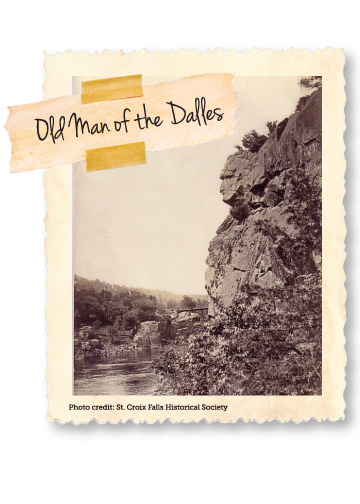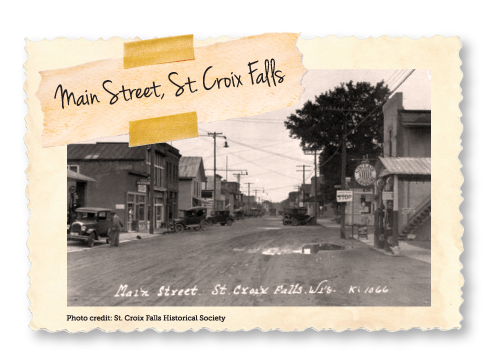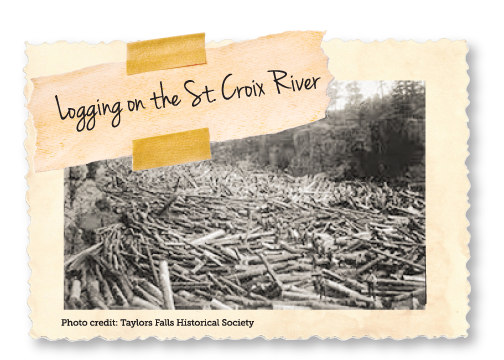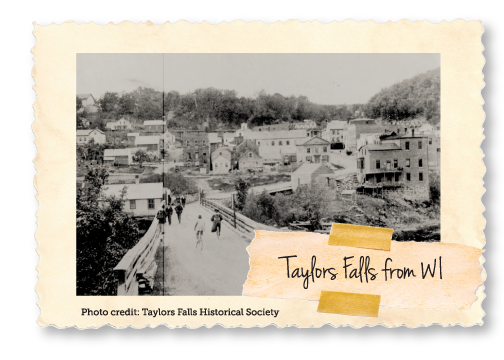Scenes from the St. Croix
A HISTORICAL OVERVIEW OF THE ST. CROIX RIVER VALLEY
photo © kelly jorgenson
HISTORY

Taylors Falls, MN & St. Croix Falls, WI
Located on a unique stretch of river, the charming sister cities of St. Croix Falls, WI and Taylors Falls, MN sit just north of Osceola, WI and are the Gateway to the Upper St. Croix River Valley. This Valley carved hundreds and thousands of years ago by glaciers, is a popular vacation destination featuring parks, ample recreation, delicious dining, unique shopping, and convenient lodging.
The St. Croix River Valley and its surrounding area were originally occupied by the semi-nomadic American Indian Tribes. These people lived mainly on wild rice, fish and game. As the valley moved into the eighteenth century, two primary tribes inhabited the area, the Ojibwe and the Dakota. Eventually, the Dakota were driven out of the area after the Battle of Kathio.
In the 1830s, immigrants began to settle on both sides of the Upper St Croix River Valley. A lush history of French fur trade, interchange with the native people of the St. Croix, and western expansion led to a period in history that began the logging and immigration eras that forever changed the St. Croix River Valley. Taylors Falls and St. Croix Falls became the northernmost site navigable by steamboat attracting entrepreneurs of all kinds.
The Swedish, Danish, Norwegian, German and others came to this area, but because of Vilhelm Moberg’s writings, Chisago County is noted in Minnesota and remembered/celebrated in Sweden. Taylors Falls was the primary gateway for the earliest Swedish settlers coming on steamboats up the St. Croix River and the many thousands who followed, establishing settlements throughout Chisago County. The first four Swedish families to the Taylors Falls landing on April 23, 1851, were met by another Swede, Eric Nordberg, whose letters enticed them to come by steamboat from Moline, Illinois. The history of this first-party came alive in Vilhelm Moberg’s novels and the motion pictures “The Emigrants” and “The New Land.”

The famous log jam of 1886 intrigued reporters and photos of the colossal log piles were published all over the world. These piles reached into the Dalles and backed up for nearly seven miles north on the river. This region soon became threatened by the mining industry prompting community leaders from both the Minnesota and Wisconsin sides to take action to preserve this exquisite valley. These leaders worked together to establish the first interstate park in the nation consisting of approximately 1,600 acres.
In 1907 the river’s great power was harnessed by the creation of a hydroelectric dam. This dam supplied power to the Minneapolis and St. Paul metropolitan areas and served as the entry to the upper St. Croix River. It has been protected since 1968 under the Wild & Scenic Rivers Act.

In addition to all this production, historic buildings are found in both communities. A neighborhood reminiscent of a New England-style village, known as the Angel Hill District, is one of the attractions on the Taylors Falls side of the Valley. This district is home to the 1855 Folsom House (a Minnesota State Historic Site and stately home of a lumber baron), the 1861 United Methodist Church (the second oldest operating church in Minnesota), and the oldest schoolhouse in Minnesota built in 1852. The Baker Land & Title Building (Queen Anne Style) and the Auditorium are located on the St. Croix Falls side and are both on the National Register of Historic Places. These historic places are nestled amongst many historic commercial and residential buildings.
The geology of the Upper St. Croix Valley is unique in itself as it hosts claim to a scenic gorge, exposed cliff rocks remnant of ancient flood basalts, potholes, moraine deposits, and the Wellness Esker. Explorers of all ages are sure to enjoy the great St. Croix River Valley. Visit the itinerary page today to plan your adventure.

st. croix vallley trivia
FUN FACTS!
What is a Wannigan?
What is a Dalles?
Where are the Falls?
What is a Pothole?
What is an Esker?
Our Story
Although the sister towns of Taylors Falls and St. Croix Falls are in different states, they share a common history and a scenic, natural beauty that spans from either side of the river that divides them. Picturesque villages with historic main streets dot the St. Croix River banks atop towering bluffs, only slightly breaking the lush forests and wild vegetation around them. To paddle the river or hike a nearby trail evokes a feeling of timelessness, as through traversing a path that has existed just so since the dawn of time. But nature and humans have lent a hand to continually evolve this landscape and shape it into what it is today.
photo © TAYLORS FALLS HISTORICAL SOCIETY

HISTORICAL TIMELINE
Geology sets the stage
Early human inhabitants
The Dakota and Ojibwe
Fur Traders Seek their Fortunes
Lumbermen Lured by White Pine Forests
Farm Culture Grows
Preservation Leads to Recreation
A Tale of Two Cities: Taylors Falls & St. Croix Falls
Geology sets the stage
Early human inhabitants
The Dakota and Ojibwe
Fur Traders Seek their Fortunes
Lumbermen Lured by White Pine Forests
Farm Culture Grows
Preservation Leads to Recreation
A Tale of Two Cities
Create your own self-guided historical tour of the notable buildings, landmarks, points of interest, and natural resources that make up our beautiful St. Croix Valley.
Glacial Potholes at Interstate Park
The Old Man of the Dalles
Eskers
Ice Age Interpretive Center
Site of the Battle of the Dalles
1825 Treaty Boundary
“St. Croix River” on Maps and Signs
Trading Posts
Angle Rock
Nevers Dam
Original St. Croix Boomsite
The First Saw Mill in the Valley
The St. Croix Falls Lumber Company
Old Barns and Farms
SOO Line Railroad
Taylors Falls Scenic Boat Tours
The Immigrant Trail
Town House School
W.H.C. Folsom House
Angel’s Hill District
Taylors Falls Public Library
Taylors Falls Saloon & Jailhouse
Taylors Falls Depot
Cushing Land Agency
Lamar Community Center
St. Croix Falls Civic Auditorium
Thompson House
Wovcha, Daniel S., and Barbara C. Delaney, and Gerda E. Nordquist. Minnesota’s St. Croix River Valley and Anoka Sandplain: A Guide to Native Habitats. Minneapolis: University of Minnesota Press, 1995
McMahon, Eileen M., and Theodore J. Karamanski. North Woods River: the St. Croix River in Upper Midwest History. Madison: University of Wisconsin Press, 2009.
Folsom, William Henry Carman. Fifty years in the Northwest. With an Introduction and Appendix Containing Reminiscences, Incidents and Notes. St. Paul: Pioneer Press Company, 1888.
Dunn, James Taylor. The St. Croix: Midwest Border River. St. Paul: Minnesota Historical Society Press, 1979, reprinted with arrangement by Henry Holt and Company, Inc.
“Baker Land and Title Company Records, 1879-1958.” University of Wisconsin Digital Collections, http://digicoll.library.wisc.edu/cgi/f/findaid/findaid-idx?page=home;c=wiarchives;cc=wiarchives. Accessed January 2019.
“Folsom House.” Minnesota Historical Society, www.mnhs.org/folsomhouse/learn. Accessed January 2019.
“Snake River Fur Post.” Minnesota Historical Society, www.mnhs.org/furpost. Accessed November 2018.
“Immigrant Trail District (mile post 39.5 – 55.1).” St. Croix Scenic Byway, stcroixscenicbyway.org/PDF/109%20Immigrant%20Trail%20District.pdf. Accessed December 2018.
“Immigrant Trail.” St. Croix Scenic Byway, stcroixscenicbyway.org/immigrant-trail/. Accessed December 2018.
“Geology and Glacial History.” St. Croix Scenic Byway, http://stcroixscenicbyway.org/PDF/101%20Geology%20and%20Glacial%20History.pdf. Accessed October 2018.
“Dakota and Ojibwe History.” St. Croix Scenic Byway, http://stcroixscenicbyway.org/PDF/110%20Dakota%20and%20Ojibwe%20History.pdf. Accessed October 2018.
“Logging.” U.S National Park Service: St. Croix National Scenic Riverway, https://www.nps.gov/sacn/learn/historyculture/logging.htm. Accessed October 2018.
“Stories.” U.S National Park Service: St. Croix National Scenic Riverway, https://www.nps.gov/sacn/learn/historyculture/stories.htm. Accessed October 2018.
“Places.” U.S National Park Service: St. Croix National Scenic Riverway, https://www.nps.gov/sacn/learn/historyculture/places.htm. Accessed October 2018.
“Research: Ruins of a Forgotten Highway.” U.S National Park Service: St. Croix National Scenic Riverway, https://www.nps.gov/sacn/learn/historyculture/upload/SCR-Issue3.pdf. Accessed October 2018.
“Archeological Sites.” U.S National Park Service: St. Croix National Scenic Riverway, https://www.nps.gov/sacn/learn/historyculture/archeological-sites.htm. Accessed October 2018.
“Fur Trade.” U.S National Park Service: St. Croix National Scenic Riverway, https://www.nps.gov/sacn/learn/historyculture/fur-trade.htm. Accessed October 2018.
“St. Croix: A Northwoods Journey.” U.S National Park Service: St. Croix National Scenic Riverway, https://www.nps.gov/sacn/learn/photosmultimedia/multimedia.htm. Accessed November 2018.
“Nevers Dam…The Lumberman’s Dam.” Minnesota Department of National Resources, http://files.dnr.state.mn.us/destinations/state_parks/wild_river/nevers_dam.pdf. Accessed January 2019.
“Taylors Falls Walking Tour: Part 1.” Presented by the City of Taylors Falls and the Heritage Preservation Commission, https://www.youtube.com/watch?v=tHZjeYAZRV4. Accessed December 2018.
“Taylors Falls Walking Tour: Part 2.” Presented by the City of Taylors Falls and the Heritage Preservation Commission, https://www.youtube.com/watch?v=piZrNsO1POQ. Accessed December 2018.
“Town House School.” The Historical Marker Database, https://www.hmdb.org/Marker.asp?Marker=78666. Accessed January 2019.
The Old Jail, http://www.oldjail.com/index.html. Accessed January 2019.
Swedish Circle tour information: www.swedishcircletours.com
This article was written by Karen Lawrence and produced by Linda Shober Marketing + Design, with input from Barb Young.
